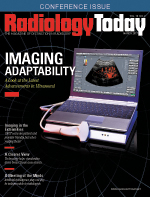 March 2017
March 2017
Inside View: AI on the Rise — Artificial Intelligence's Expanding Role in Imaging
By José Morey, MD, and Justine Kemp
Radiology Today
Vol. 18 No. 3 P. 7
Radiologists are experiencing increasing demands to be more efficient with reading images, and this pressure will intensify as health care in the United States shifts to a more value-based model. Demand for image interpretation has increased to the point that a significant number of hospitals are now reportedly outsourcing their images to private firms. Some sources estimate that hospitals outsource more than 90% of their imaging, but, for the in-house radiologists at the hospital, there are still plenty of images to be read. The question becomes, "Why are so many images outsourced, and why can't the radiologists working in the hospital keep up?"
Woojin Kim, MD, chief medical information officer at Nuance Communications, states the problem: "There is greater emphasis on the quality and value of radiology reports."
As evidenced by the ACR's Imaging 3.0 initiative, it has never been more important for radiologists to transform from a fee-for-service-based model of health care to one based on value-based care. Therefore, it has never been more important to focus on the efficiency and quality of radiologic image interpretation. Artificial intelligence (AI) is helping to shape this change and provide radiologists with the tools necessary to become more efficient without compromising the value of the radiologist's report.
Improving Workflow
AI is taking precedence in the medical field as demand for physicians and better patient care continually increases. AI programs, such as IBM Watson, are already attracting attention for the ways in which they may be able to help radiologists. The preliminary form of IBM Watson could have several primary goals. The first could be to identify potentially dangerous patterns in images to prioritize which ones are read first. For example, if a patient's CT scan shows signs of severe inflammation, as recognized by the machine, this may take priority over another abdominal CT scan with no overt signs of pathology.
Furthermore, with images of high importance, the program could autopopulate the report with descriptions of the patterns it has recognized, helping the radiologist to move faster. For instance, if the main concern is appendicitis and the program prioritizes this image highly, it could then provide a brief description of the pattern, saving the radiologist from having to describe the finding. To further save time, IBM Watson's programmers hope to develop the ability to comb through a patient's medical records, giving the radiologist immediate context about the patient's history at the time of image interpretation. This additional information could lessen confusion and improve interpretation of the image. The overall goal is to decrease the time it takes to get important images read with reduced error, hopefully lowering patient morbidity and mortality.
AI can and should be taken one step further in terms of improving workflow for radiologists. If a prior image is available, a radiologist will compare the present-day image with the prior one. This is important in terms of determining pathological change over time. For instance, in monitoring for a given cancer, tumor growth over time and response to treatment are important prognostic factors. AI could be built into PACS to superimpose a past cross-sectional CT/MRI scan on the present-day scan. From there, the program would immediately measure the tumor growth or shrinkage observed. This information would then be autopopulated into the radiology report.
Furthermore, new programs could also be developed so that a radiologist could simply click over an observed lesion to have it immediately measured in 3D. This type of measuring device could also be used to immediately measure all major organs and vessels and populate the report with relevant measurements. These improvements could lessen the time required for a radiologist to read an image.
According to Kim, "Machine learning [ML] is one technology that will disrupt the industry. The exact manner in which ML will disrupt this industry remains to be seen. Having said that, one of the ways will be to take clinical decision support to a new level to assist radiologists to detect findings on images and make diagnoses faster and with greater accuracy." Moreover, with the machine recognizing both major patterns on images and immediately measuring all relevant structures, it would allow the radiologist more time to focus on subtle pathologies.
With progressions and improvements in technology occurring rapidly, radiologists, doctors, and patients can benefit tremendously from the advancements that IBM Watson and other AI programs can offer.
— José Morey, MD, is a senior medical scientist for IBM Research; a visiting assistant professor in the department of radiology and medical imaging at the University of Virginia; medical technology and artificial intelligence officer for NASA iTech; senior engineer specialist for Hyperloop Transportation Technologies; and director of innovation, informatics, and cognitive computing for Medical Center Radiologists in Virginia Beach, Virginia.
— Justine Kemp is an MD/MBA candidate at the Tulane University School of Medicine and AB Freeman School of Business in New Orleans.

